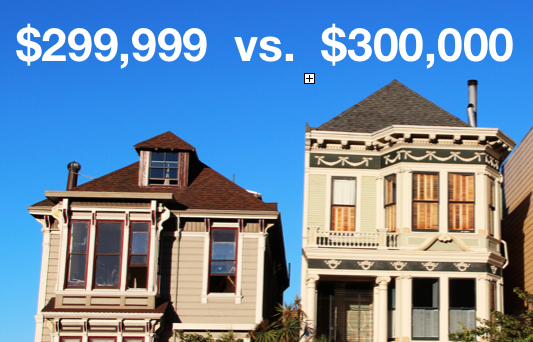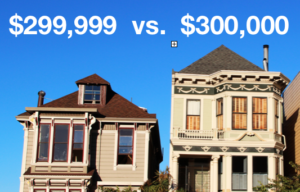Infomercials have been doing it for years. Why is every product sold on TV at 2AM offered for $19.99 or some version of it? As opposed to an even $20?
The shoe industry does the same thing. Shoes are usually $99 instead of $100.
The car industry has been doing it to an even greater extreme. Cars are all manner of odd number pricing like $23,560 or $49,870.
So naturally sellers of houses and the agents hired to help them, for years now, have used this same technique. On the surface, there seems to be some merit in offering a house for $199,999 instead of $200,000. After all, that “1” in front of those six digits looks way better than a “2”. Right?
Or does it really matter when it comes to six digits? Or even five? Would you feel like you’re getting a crazy good deal on a house priced at $99,999 versus $100,000? Probably not. Some might say these are just silly psychological tricks that aren’t as effective on big ticket items like houses. One dollar difference on six figures likely makes far less impact in the minds of buyers than on a $99 pair of shoes. So is odd number pricing an out of date tactic or something that really has merit in today’s real estate market? If it were all about the the psychology of a buyer’s mind, then I’d say it doesn’t matter one bit.
But there is a far more important reason why odd number pricing can cost you money on your house. And for way more than one dollar.
It’s about the internet search. Once upon a time, most home search websites were set up for buyers to choose from a select list of ranges. $0-$99,999 or $100,000 – $149,999, etc. But now most sites simply leave a blank box for the online shopper to enter her price range of choice. And guess what most buyers use in their online searching? That’s right. $100,000 to $150,000 or $350,000 to $400,000.
Rarely does an online home shopper use any version of “9” in their price criteria. What that means to a home seller is that when they price their home at $199,999 instead of $200,000, they are being seen by buyers with searches ending in $200,000 but NOT seen by buyers searching from $200,000 and up…a huge additional set of potential buyers.
That’s why for fifteen years now, I have been advising my sellers to let me use even number pricing on my listings. There really is no downside to bucking the old fashioned $999 style pricing strategy in favor of the smarter, even number method. More online eyeballs means a higher chance of multiple offers. And multiple offers is the best way to get over asking price. Creating an auction style atmosphere is the seller’s best chance for getting top dollar. That requires the most buyers vying for your home as possible. And pricing in round numbers, preferably in $5,000 and $10,000 increments, is the first step to such a result. It’s step one in my smart pricing strategy method.
There are more steps involved in pricing strategy as well. We’ll talk about those in another blog post. For now, if you are currently on the market with an odd number price, and your traffic has slowed down, consider adjusting to an even number. That one dollar, or nine dollar, or nineteen dollar change just might bring a whole new set of offers to your doorstep.


